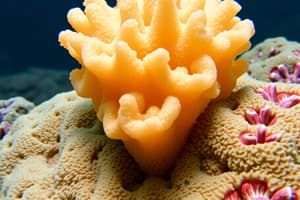Podcast
Questions and Answers
What is the function of ostia in sponges?
What is the function of ostia in sponges?
- To remove wastes from the sponge
- To provide structural support to the sponge
- To generate a flow of water
- To bring in food and oxygen (correct)
Which structure in sponges is responsible for the exit of water?
Which structure in sponges is responsible for the exit of water?
- Collagen fibers
- Mesohyl
- Spicules
- Oscula (correct)
What is the purpose of the unique water current system in sponges?
What is the purpose of the unique water current system in sponges?
- To aid in feeding and gas exchange (correct)
- To assist in reproduction
- To provide shelter for other marine organisms
- To regulate the sponge's body temperature
Which component forms the stiffening skeletal structure of sponges?
Which component forms the stiffening skeletal structure of sponges?
What do sponges lack compared to more complex metazoans?
What do sponges lack compared to more complex metazoans?
What is the term for the clusters of cells surrounded by a protective coat that are involved in asexual reproduction in sponges?
What is the term for the clusters of cells surrounded by a protective coat that are involved in asexual reproduction in sponges?
Which type of stem cell in sponge embryos is considered totipotent and can potentially give rise to an entire organism?
Which type of stem cell in sponge embryos is considered totipotent and can potentially give rise to an entire organism?
During sponge embryonic development, what is the term for the stage where the zygote does not form a gastrula blastula?
During sponge embryonic development, what is the term for the stage where the zygote does not form a gastrula blastula?
Which type of cell in adult sponges produces a few cell types like sclerocytes and germ cells but not an entire organism?
Which type of cell in adult sponges produces a few cell types like sclerocytes and germ cells but not an entire organism?
Which type of larva is released into the water during sponge sexual reproduction before eventually settling and undergoing metamorphosis?
Which type of larva is released into the water during sponge sexual reproduction before eventually settling and undergoing metamorphosis?
What is the term for the process of fertilization, followed by release of a planktonic larva and its eventual settlement and metamorphosis in sponges?
What is the term for the process of fertilization, followed by release of a planktonic larva and its eventual settlement and metamorphosis in sponges?
Flashcards
Ostia
Ostia
Tiny openings on the surface of sponges that allow water to enter the body.
Oscula
Oscula
Large openings on sponges where water exits after passing through the internal canals.
Water current system
Water current system
A unique system of canals and chambers in sponges that facilitates water flow, bringing in food and oxygen and removing waste.
Spicules
Spicules
Signup and view all the flashcards
Germ layers
Germ layers
Signup and view all the flashcards
Gemmules
Gemmules
Signup and view all the flashcards
Archeocytes
Archeocytes
Signup and view all the flashcards
Hollow stage
Hollow stage
Signup and view all the flashcards
Archeocytes
Archeocytes
Signup and view all the flashcards
Planktonic larva
Planktonic larva
Signup and view all the flashcards
Sexual reproduction
Sexual reproduction
Signup and view all the flashcards




